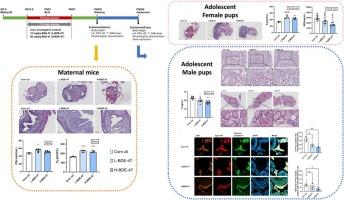2,2 ',4,4 ' -四溴联苯醚(BDE-47)暴露对青春期后代生殖发育的影响
IF 3.4
3区 医学
Q2 PHARMACOLOGY & PHARMACY
引用次数: 0
摘要
已知多溴联苯醚(PBDEs)会破坏神经内分泌功能,损害围产期生长和生殖健康。然而,围产期接触多溴二苯醚后的长期生殖毒性仍然知之甚少。本研究探讨围产期接触2,2 ',4,4 ' -四溴联苯醚(BDE-47)对青春期后代生殖发育的影响。雌性C57BL/6 J小鼠在围产期(妊娠第13.5天至出生后第7天)以0(对照)、10和50 mg/kg剂量暴露于BDE-47。随后,收集青春期子代小鼠的性腺组织和血清进行分析。用苏木精和伊红(H&;E)染色对性腺组织切片进行组织学检查,发现结构改变。采用ELISA法测定母鼠及子代血清中生殖内分泌激素(E2、LH、FSH、AMH、T)水平。采用多重免疫组化(mIHC)染色法观察青春期雄性幼犬睾丸间质蛋白的表达。在母鼠中,围产期暴露于BDE-47导致原发和继发卵母细胞数量增加,同时卵巢黄体数量减少。此外,10 mg/kg BDE-47组子宫内膜厚度增加,血清E2水平升高。在青春期雌性后代中,两种剂量下卵巢中继发卵母细胞和黄体增加,血清E2水平升高,而10 mg/kg BDE-47组AMH水平下降。在雄性后代中,睾丸结构松动,一些生精细胞脱落,细胞质空泡化。与对照组相比,附睾上皮细胞较短,呈空泡结构,精子含量减少。睾酮分泌随剂量增加而相应减少。与激素变化一致,暴露于50 mg/kg BDE-47的青春期雄性幼崽睾丸间质中cyp11a1阳性细胞和StAR和cyp11a1双阳性细胞减少,提示甾体生成酶功能障碍。综上所述,围产期暴露于BDE-47会破坏母鼠和子鼠性腺组织结构,影响激素水平,损害类固醇激素的正常合成,从而产生生殖毒性作用。这些发现强调了围产期接触BDE-47可能带来的长期生殖健康风险,并强调需要进一步研究以阐明潜在机制和制定预防战略。本文章由计算机程序翻译,如有差异,请以英文原文为准。

Impact of 2,2′,4,4′-tetrabromodiphenyl ether (BDE-47) exposure on reproductive development in adolescent offspring
Polybrominated diphenyl ethers (PBDEs) are known to disrupt neuroendocrine functions and impaired perinatal growth and reproductive health. However, the long-term reproductive toxicity of PBDEs following perinatal exposure remains poorly understood. This study investigated the effects of perinatal exposure to 2,2′,4,4′-tetrabromodiphenyl ether (BDE-47) on reproductive development in adolescent offspring. Female C57BL/6 J mice were exposed to BDE-47 at doses of 0 (control), 10, and 50 mg/kg during the perinatal period (gestational day 13.5 to postnatal day 7). Subsequently, gonadal tissues and serum were collected from adolescent offspring mice for analysis. Histological examination of gonadal tissue sections using hematoxylin and eosin (H&E) staining revealed structural alterations. ELISA was employed to evaluate the reproductive endocrine hormone levels (E2, LH, FSH, AMH and T) in the serum of dams and offspring. Subsequently, multiplex immunohistochemical (mIHC) staining was employed to observe the protein expression in the testicular stroma of adolescent male pups. In maternal mice, perinatal exposure to BDE-47 led to an increased number of primary and secondary oocytes, accompanied by a decreased number of corpora luteum in the ovaries. Additionally, an increase in endometrial thickness and elevated serum E2 levels was observed in the 10 mg/kg BDE-47 group. In adolescent female offspring, an increase in secondary oocytes and corpora lutea in ovaries were found, along with increased serum E2 levels at both doses, while AMH levels decreased in 10 mg/kg BDE-47 group. In male offspring, testicular structural loosening, detachment of some spermatogenic cells, and cytoplasmic vacuolation were noted. The epididymal epithelial cells were shorter compared to the control group, with vacuolar structures and reduced sperm content. Testosterone secretion was decreased correspondingly with increasing dose. Consistent with the hormonal changes, a decrease in Cyp11a1-positive cells and StAR and Cyp11a1dual-positive cells was observed in the testicular stroma of adolescent male pups exposed to 50 mg/kg BDE-47, suggesting dysfunction of steroidogenic enzymes. In conclusion, perinatal exposure to BDE-47 disrupts the structure of gonadal tissues in both maternal and offspring mice, affects hormonal levels, and impairs the normal synthesis of steroid hormones, thereby exerting reproductive toxicity effects. These findings highlight the potential long-term reproductive health risks associated with perinatal exposure to BDE-47 and underscore the need for further research to elucidate the underlying mechanisms and develop preventive strategies.
求助全文
通过发布文献求助,成功后即可免费获取论文全文。
去求助
来源期刊
CiteScore
6.80
自引率
2.60%
发文量
309
审稿时长
32 days
期刊介绍:
Toxicology and Applied Pharmacology publishes original scientific research of relevance to animals or humans pertaining to the action of chemicals, drugs, or chemically-defined natural products.
Regular articles address mechanistic approaches to physiological, pharmacologic, biochemical, cellular, or molecular understanding of toxicologic/pathologic lesions and to methods used to describe these responses. Safety Science articles address outstanding state-of-the-art preclinical and human translational characterization of drug and chemical safety employing cutting-edge science. Highly significant Regulatory Safety Science articles will also be considered in this category. Papers concerned with alternatives to the use of experimental animals are encouraged.
Short articles report on high impact studies of broad interest to readers of TAAP that would benefit from rapid publication. These articles should contain no more than a combined total of four figures and tables. Authors should include in their cover letter the justification for consideration of their manuscript as a short article.

 求助内容:
求助内容: 应助结果提醒方式:
应助结果提醒方式:


